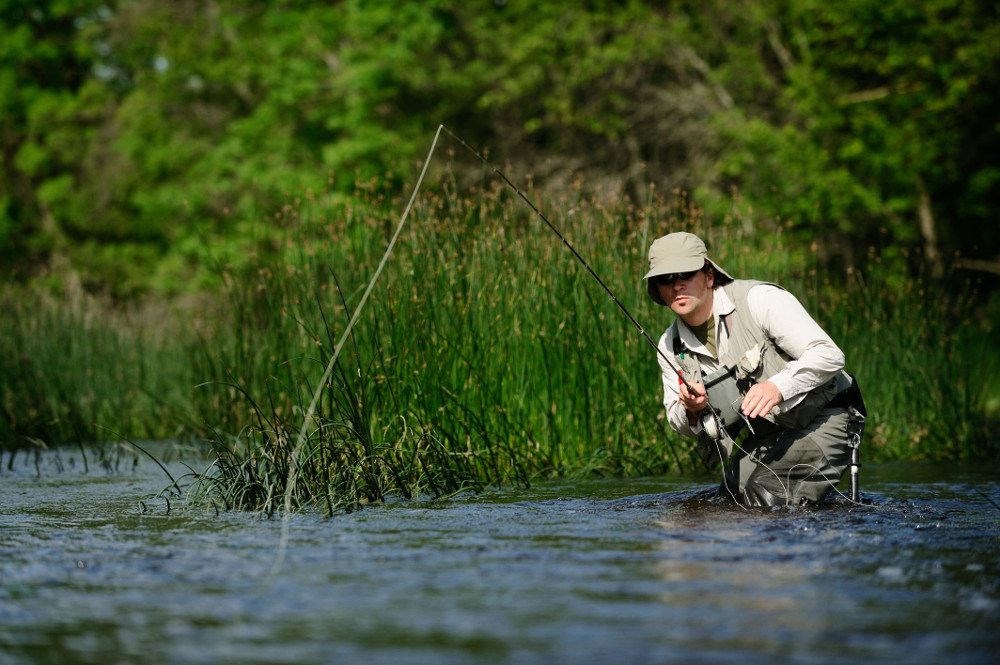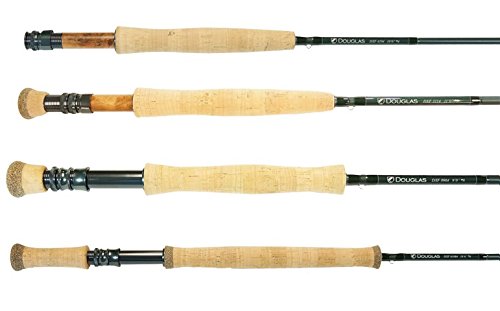Best Fly Fishing Rods Review 2019

Fly fishing is called an art form by those sportsmen who chose to answer its call. I have spent years in the back country pursuing this dream, chasing the lean, vicious Golden and Brook trout living in the cold waters of the high Sierra Nevada Mountains of California or the massive Brown or Rainbow trout cruising the Salmon River in Idaho. The skillful maneuvering of the wrist, the imitation of life so perfect that a living creature actually believes your work is alive; this is the passion that drives a fly fisherman.
However, whether you are just picking up a fly rod for the first time, or you have vast experience casting in a variety of conditions, choosing a best fly fishing rod can be somewhat overwhelming. With so much information out there regarding the market and which rod is best for you the choices might seem endless. In this article we are going to break down the pros and cons of the fly fishing rod, the best mid-range fly fishing rod, and the best high-end fly fishing rod.
…it is not fly fishing if you are not looking for answers to questions.Norman Maclean A River Runs Through It and Other Stories
A Quick Word on Fly Fishing Rod Reviews
While there is great information to be found in fly fishing rod reviews, the source of the review is important. Something that works well for a professional fly fishing guide might not work as well for an amateur fisherman. It is good to find a wide range of opinions before choosing your best fly fishing rod!
Below you will find our favorite picks and reviews of the best fly fishing rods currently available. Below these reviews you can find lots more information about what goes into a good fly fishing rod, as well as personal experiences with fly fishing that others could find beneficial as well, so feel free to check that out as well!
- Basic
- Mid-Range
- High-End

Pros
- Very affordable, so you can potentially expand your collection of flies!
- Hard chrome stripper and chromium snake guides.
- Great for beginners and experts alike.
- Excellent with dry fly casting.
- Durable; will withstand the abuse an inexperienced fly fisherman might give while learning to cast.
- Lightweight cork handle.
Cons
- Limited 5-year warranty.
- Lacks the power for longer casts (60 feet +) or heavier nymphs and streamers.
General Consensus
At such a low cost, this rod simply can not be beat in this category, particularly when casting the rod feels as if it were a far more expensive model. Fenwick has brought years of experience making high quality rods into manufacturing a model that is of a high quality yet affordable on any budget.

Pros
- Deadly accurate at short to mid-range distances.
- Simple, classic finish.
- Lightning fast action.
- High-quality AAA cork handle.
- Burled wood reel seat.
- Available with a variety of grips and grip placements.
Cons
- Lacks a bit of power on the longer casts.
- New company, although packed with experienced people.
- Fast action is less forgiving with novice casters.
General Consensus
As with the G. Loomis (see high-end selection), the Douglas DXF fly fishing rod is quickly becoming a crowd favorite. The manager (Jim Murphy) came from Hardy to this young company in New York and brought with him years of manufacturing experience. This rod will perform almost as well as fly fishing rods nearly double the price!
When you are ready to move up from your basic fly fishing rod, but are not quite ready for the investment a high-end fly fishing rod entails, this is your choice. The Douglas Company, though lacking the storied history of some other popular manufacturers, is already winning competitions for accuracy and most importantly value for your dollar.
G.Loomis NRX LP Fly Fishing Rod

Pros
- Incredible accuracy with both long and short casts.
- Undisputed leader among higher end fly fishing rods.
- Powerful, flexible, smooth delivery.
- Progressive medium action.
- Works spectacularly with both nymphs and streamers.
Cons
- Slightly less powerful with longer distance casts than comparable rods.
- Lifetime warranty is only for the original owner, so this is one to buy new!
- Heavier streamers will slow down your stroke.
General Consensus
For years the G. Loomis NRX LP fly fishing rod has won the prestigious 5-weight shootout hosted by Yellowstone Anglers. This rod is a dream to cast and will bring many hours of delight to your next expedition!
The G. Loomis NRX LP fly fishing rod is by far the favorite of expert fly fishing guides, fly shop owners and experienced fly fishing enthusiasts, and for good reason. In independent reviews throughout the years it consistently wins out over the other high-end fly fishing rods in its category. This rod consistently pleases and when you are ready to move into a higher end model of fly fishing rod, this is your best choice!
Insider Tip: For longer rods (9′ or above) use Scientific Angler’s GPX line for that perfect cast. For shorter rods, try Rio’s Gold line to get the most out of your rod!
I don’t like these rods! What are my other options?
Well, asking a fisherman which rod he prefers is a lot like asking a chef what sort of food he prefers; opinion plays a major role in the answer he provides! I have chosen these options being that not only do I prefer them, but the majority of opinions in the fly fishing community seem to converge on these particular choices. If you still want to do more research, some good companies to start with would be Orvis, Temple Creek, Sage, Scott, Reddington, and St. Croix. Please remember to check out the guidelines posted below in this article for your target specs and have fun searching!
If you prefer a different type of rod altogether, don’t hesitate to check out our information on spinning rods, baitcasting rods, and the best all-around fishing rods!
What makes a good fly fishing rod?
There are many qualities that make for a great fly fishing rod. The type of fly fishing rod, the weight and balance, the action, the finish, the grip, the materials used in construction…all of these qualities combine to form a rod that is best suited for you to take on your next fishing expedition. Of course, you can also improve your setup by combining the rod with an appropriate fly fishing reel as well, but we’ll leave that for another article.
Fly Fishing Rod Materials, Grips, and Finish
Modern fly fishing rods are most commonly made from graphite or fiberglass. Both of these materials have their pros and cons. Fiberglass fly fishing rods can be tougher, more durable, and unless they are custom-built will cost you less to purchase, while graphite fly fishing rods are generally lighter and if taken care of will last for many years.
The finish of a rod might seem to focus on the aesthetic rather than the functional but this is important for a variety of reasons. The rod will be in your hand for hours at a time; the composition of the grip and the appearance of the rod will become well known to you within a short time and if either are not pleasing this will take away from your fishing experience.
Most popular rods will exhibit muted, natural tones and do not draw attention to the cast. I have fished in places where the slightest shadow cast over the water will send the trout scurrying for cover, let alone a brilliant color unknown in the natural world! As my grandfather used to say, be sure your gear and tackle is pleasing to the fish, not just the fisherman.
I find the most pleasing grip to be fashioned from high-quality cork (also the most popular grip material), however, I urge you to experiment with a variety of grips to find what works for you.
Fly Fishing Rod Weight
Fly fishing rods from 0-3 weight are called ultra-light fly fishing rods. These work well for smaller creeks and streams and have extremely slow action. The mid-weight category (4-6) is used as a catch-all for most situations you will encounter while fly fishing. The heavier weight rods (7-10+) are used for steelhead trout and bass, long cast presentations, and in situations where a heavy nymph or streamer is needed to bag that prize fish!
Fly Fishing Rod Action
The action of a fly fishing rod refers to how deeply the rod will bend during your cast. Slow action rods are lighter, more flexible, bend throughout the length of the rod, and will load slowly, while fast action rods are heavier, less flexible, bend primarily in the upper section of the rod, and will load more quickly. Loading a fly rod is a concept that refers to the time it takes to feel a pull during the pause between your forward and backward cast. When you feel the slight pull, the line has straightened behind you (this is known as loading the rod tip), and it is possible to move into your forward stroke with less chance of a tangle and higher chance of that perfect presentation. Most 5-weight fly fishing rods will have medium to fast action.
Fly Fishing Rod Length
It is important to determine where you will be using your fly fishing rod before you chose the perfect length. While I am fishing small streams in the backcountry of King’s Canyon in California, where the brush lies heavily along the sides of the water and the trout lie waiting in slight bends or rocky pools beneath small waterfalls, a shorter rod enables me to present my fly to the fish while my cast is restricted to a shorter arc.
However, while in open area, wading along the broad Chattahoochee or Salmon in search of larger game-fish, I find I need a longer rod with fast action to power the cast with windy conditions or lengthy presentations. I would suggest choosing something in the eight to nine-and-a-half foot range if you are in the market for an all-round rod to meet all of your needs.
Why Fly Fishing?
The quote in the beginning of the article sums up the spirit of fly fishing. When I enter an area with my gear, I begin with a scan of the environment, starting with where I think the fish will be hiding.
Most of my fly fishing experience comes from back country excursions where trout is on the menu, and perhaps the only thing on the menu, so my dinner depends on my success with the fly fishing rod!
The real pull for fly fishing (at least for me) is not only that I am out in nature, enjoying a cool evening on a wooded stream bank or knee-deep in a fast flowing river, but the solution to the problems the world presents. I might cast into four different pools along the same watercourse and not use the same technique twice.
An overhanging branch or dead-fall leaning across the stream might change all of your motions, all of your focus. That broad, beautiful river you spent days pulling out lunkers and wall-mount specimens could turn into a logistical nightmare with a bit of wind, or rain further up the watercourse and increased flow.
If the fish does not believe your fly is alive, it will not strike, and therefore the measure of your success depends on your ability to solve the problem of presentation.
I remember trekking across Chilean Patagonia with my fishing gear in hand, hoping to land some of the calf-sized brown trout lazily drifting in crystal-clear glacier fed rivers. I was striking out until I met an old Chilean Gaucho, who was using the strangest technique I had ever seen.
We headed out together along the river bank trail from his little ranch and before we arrived to his sweet spot, he dug up some fresh worms to weight his dry fly down, like a nymph or wet fly. I smiled to myself and we set to casting along one of the most beautiful river banks I have ever seen, sunlight glancing off the smooth clear water, thick Patagonian bamboo sidewalking the shores, an old ranch hound lounging close to his master’s feet.
I did not pull in one fish that day. My gaucho friend, however, not only cooked us a delicious fried fish dinner, but sent me along my way with a backpack full of salted brown trout to eat further up in the Patagonian mountains I was headed to for a climb. So after you pick your choice rod, gear up with your favorite reel (check my suggestions here), and stock your inventory of tackle, be sure to stay humble, and don’t be afraid to take a lesson from the locals!
Happy Fishing!
